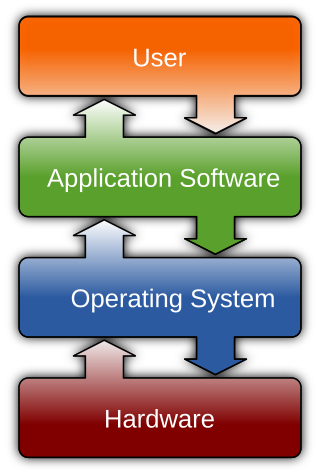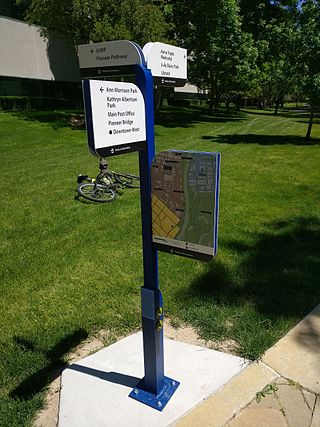Related Research Articles

In engineering and its various subdisciplines, acceptance testing is a test conducted to determine if the requirements of a specification or contract are met. It may involve chemical tests, physical tests, or performance tests.

Software is a set of computer programs and associated documentation and data. This is in contrast to hardware, from which the system is built and which actually performs the work.
Grok is a neologism coined by American writer Robert A. Heinlein for his 1961 science fiction novel Stranger in a Strange Land. While the Oxford English Dictionary summarizes the meaning of grok as "to understand intuitively or by empathy, to establish rapport with" and "to empathize or communicate sympathetically (with); also, to experience enjoyment", Heinlein's concept is far more nuanced, with critic Istvan Csicsery-Ronay Jr. observing that "the book's major theme can be seen as an extended definition of the term." The concept of grok garnered significant critical scrutiny in the years after the book's initial publication. The term and aspects of the underlying concept have become part of communities such as computer science.
Software testing is the act of examining the artifacts and the behavior of the software under test by validation and verification. Software testing can also provide an objective, independent view of the software to allow the business to appreciate and understand the risks of software implementation. Test techniques include, but are not necessarily limited to:

Telemetry is the in situ collection of measurements or other data at remote points and their automatic transmission to receiving equipment (telecommunication) for monitoring. The word is derived from the Greek roots tele, 'remote', and metron, 'measure'. Systems that need external instructions and data to operate require the counterpart of telemetry: telecommand.

A prototype is an early sample, model, or release of a product built to test a concept or process. It is a term used in a variety of contexts, including semantics, design, electronics, and software programming. A prototype is generally used to evaluate a new design to enhance precision by system analysts and users. Prototyping serves to provide specifications for a real, working system rather than a theoretical one. In some design workflow models, creating a prototype is the step between the formalization and the evaluation of an idea.

In computing, internationalization and localization (American) or internationalisation and localisation, often abbreviated i18n and L10n, are means of adapting computer software to different languages, regional peculiarities and technical requirements of a target locale.
Test-driven development (TDD) is a software development process relying on software requirements being converted to test cases before software is fully developed, and tracking all software development by repeatedly testing the software against all test cases. This is as opposed to software being developed first and test cases created later.
In situ is a Latin phrase that translates literally to "on site" or "in position." It can mean "locally", "on site", "on the premises", or "in place" to describe where an event takes place and is used in many different contexts. For example, in fields such as physics, geology, chemistry, or biology, in situ may describe the way a measurement is taken, that is, in the same place the phenomenon is occurring without isolating it from other systems or altering the original conditions of the test. The opposite of in situ is ex situ.
In product development and process optimization, a requirement is a singular documented physical or functional need that a particular design, product or process aims to satisfy. It is commonly used in a formal sense in engineering design, including for example in systems engineering, software engineering, or enterprise engineering. It is a broad concept that could speak to any necessary function, attribute, capability, characteristic, or quality of a system for it to have value and utility to a customer, organization, internal user, or other stakeholder. Requirements can come with different levels of specificity; for example, a requirement specification or requirement "spec" refers to an explicit, highly objective/clear requirement to be satisfied by a material, design, product, or service.
Software maintenance in software engineering is the modification of a software product after delivery to correct faults, to improve performance or other attributes.
To reinvent the wheel is to attempt to duplicate—most likely with inferior results—a basic method that has already previously been created or optimized by others.
Software as a service is a software licensing and delivery model in which software is licensed on a subscription basis and is centrally hosted. SaaS is also known as on-demand software, web-based software, or web-hosted software.
Software project management is the process of planning and leading software projects. It is a sub-discipline of project management in which software projects are planned, implemented, monitored and controlled.

Dry firing is the practice of simulating the discharge of a firearm without any live ammunition, or practicing with an inert laser/infrared training platform and may also include the use of a target/feedback system. The terms also commonly refers to simply "firing" a gun that has no ammunition in it. Concern is commonly expressed that doing so might damage the gun.

A system is a group of interacting or interrelated elements that act according to a set of rules to form a unified whole. A system, surrounded and influenced by its environment, is described by its boundaries, structure and purpose and is expressed in its functioning. Systems are the subjects of study of systems theory and other systems sciences.

In computing, an emulator is hardware or software that enables one computer system to behave like another computer system. An emulator typically enables the host system to run software or use peripheral devices designed for the guest system. Emulation refers to the ability of a computer program in an electronic device to emulate another program or device.

Extreme programming (XP) is a software development methodology intended to improve software quality and responsiveness to changing customer requirements. As a type of agile software development, it advocates frequent releases in short development cycles, intended to improve productivity and introduce checkpoints at which new customer requirements can be adopted.
Acceptance test–driven development (ATDD) is a development methodology based on communication between the business customers, the developers, and the testers. ATDD encompasses many of the same practices as specification by example (SBE), behavior-driven development (BDD), example-driven development (EDD), and support-driven development also called story test–driven development (SDD). All these processes aid developers and testers in understanding the customer's needs prior to implementation and allow customers to be able to converse in their own domain language.
This article discusses a set of tactics useful in software testing. It is intended as a comprehensive list of tactical approaches to Software Quality Assurance (more widely colloquially known as Quality Assurance and general application of the test method.
References
- 1 2 "Dry Run « The Word Detective". www.word-detective.com. Retrieved 28 April 2021.
- ↑ Craig, Rick David; Jaskiel, Stefan P. (2002). Systematic Software Testing. Artech House. ISBN 978-1-58053-792-6.
- ↑ Schmidt, Richard (2013-04-30). Software Engineering: Architecture-driven Software Development. Newnes. ISBN 978-0-12-407878-9.